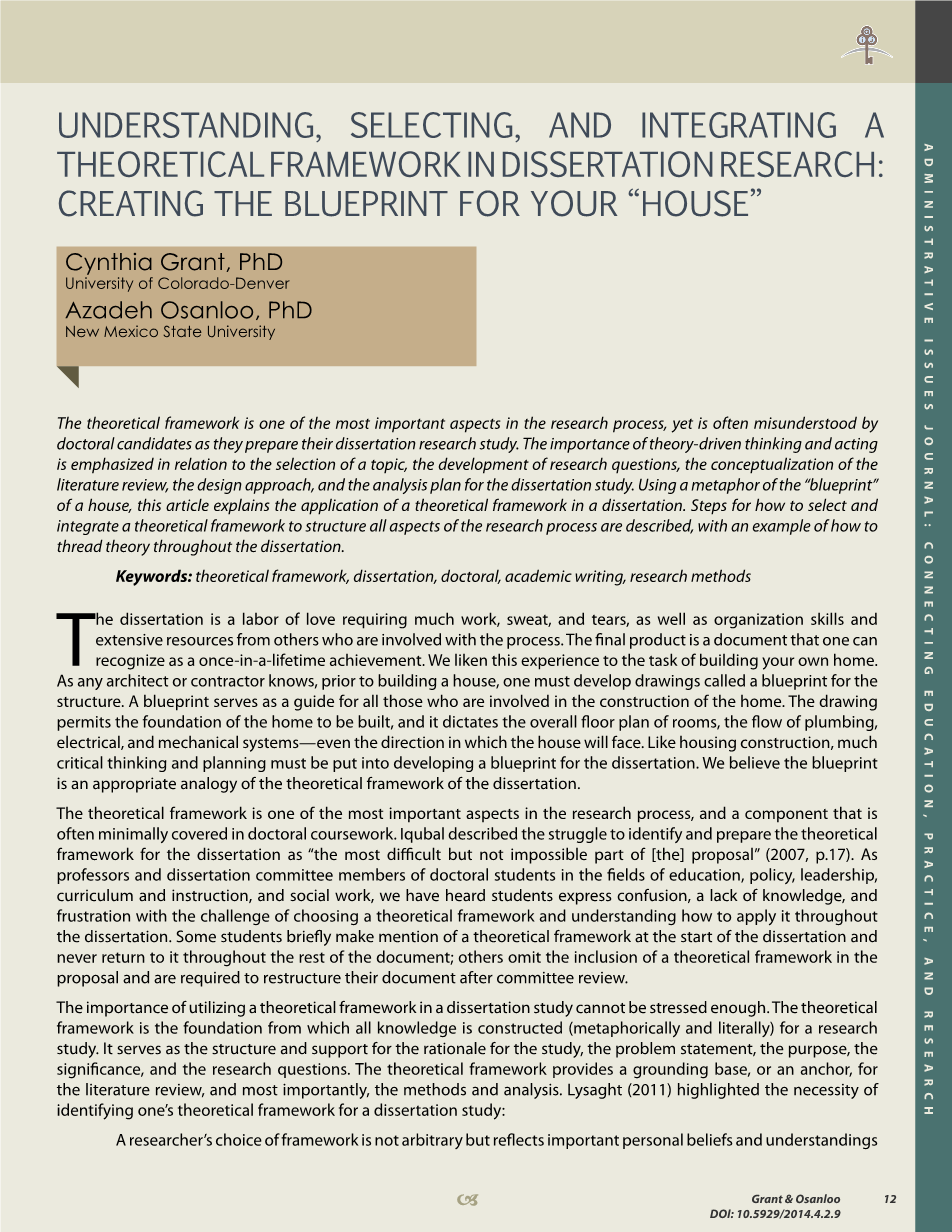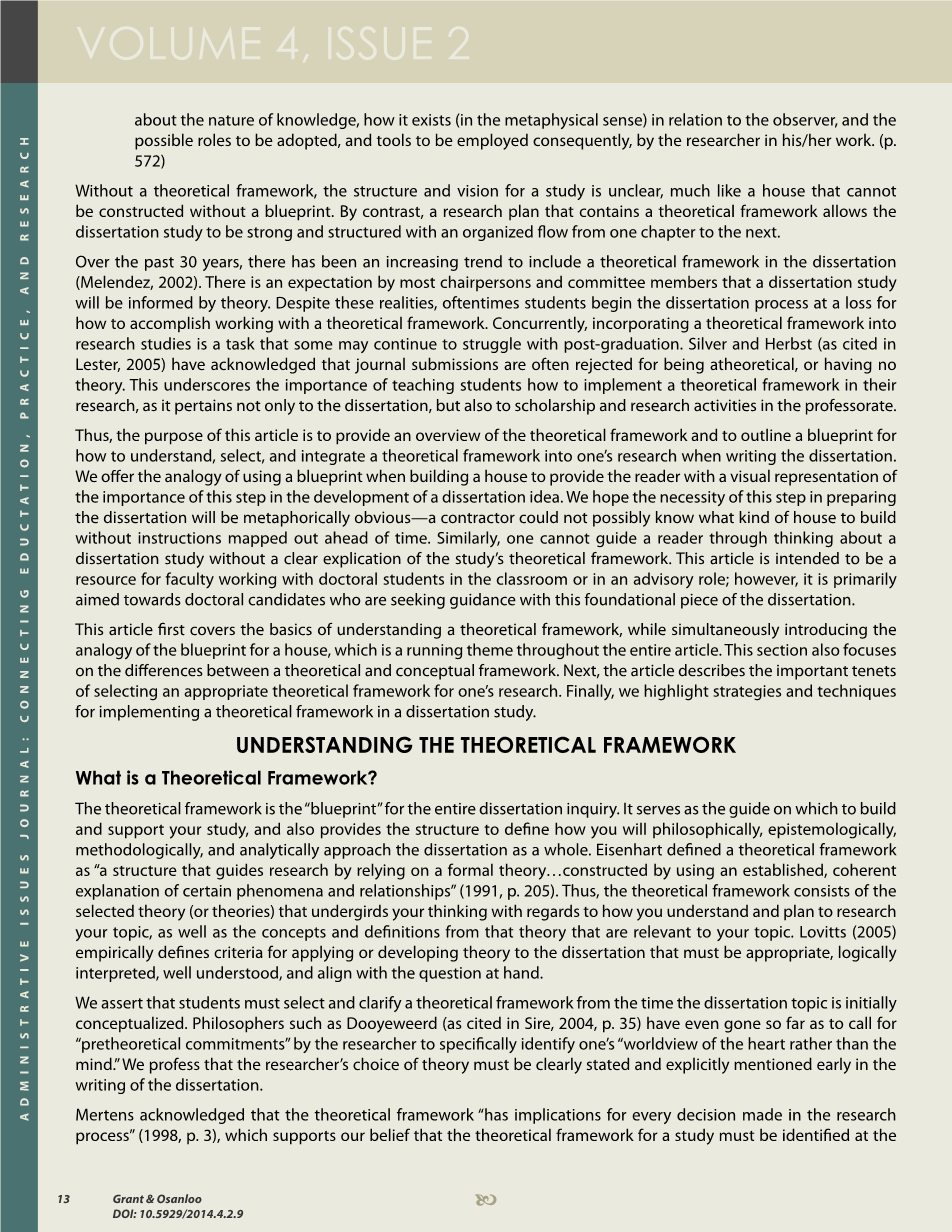本科毕业设计(论文)
外文翻译
UNDERSTANDING, SELECTING, AND INTEGRATING A
THEORETICAL FRAMEWORK IN DISSERTATION RESEARCH:
CREATING THE BLUEPRINT FOR YOUR “HOUSE”
作者:Cynthia Grant
Azadeh Osanloo
国籍:America
出处:ADMINISTRATIVE ISSUES JOURNAL: CONNECTING EDUCATION, PRACTICE, AND RESEARCH
The theoretical framework is one of the most important aspects in the research process, yet is often misunderstood by doctoral candidates as they prepare their dissertation research study. The importance of theory-driven thinking and acting is emphasized in relation to the selection of a topic, the development of research questions, the conceptualization of the literature review, the design approach, and the analysis plan for the dissertation study. Using a metaphor of the “blueprint” of a house, this article explains the application of a theoretical framework in a dissertation. Steps for how to select and integrate a theoretical framework to structure all aspects of the research process are described, with an example of how to thread theory throughout the dissertation.
Keywords: theoretical framework, dissertation, doctoral, academic writing, research methods
The dissertation is a labor of love requiring much work, sweat, and tears, as well as organization skills and extensive resources from others who are involved with the process. The final product is a document that one can recognize as a once-in-a-lifetime achievement. We liken this experience to the task of building your own home. As any architect or contractor knows, prior to building a house, one must develop drawings called a blueprint for the structure. A blueprint serves as a guide for all those who are involved in the construction of the home. The drawing
permits the foundation of the home to be built, and it dictates the overall floor plan of rooms, the flow of plumbing, electrical, and mechanical systems—even the direction in which the house will face. Like housing construction, much critical thinking and planning must be put into developing a blueprint for the dissertation. We believe the blueprint is an appropriate analogy of the theoretical framework of the dissertation.
We believe the blueprint is an appropriate analogy of the theoretical framework of the dissertation.
The theoretical framework is one of the most important aspects in the research process, and a component that is often minimally covered in doctoral coursework. Iqubal described the struggle to identify and prepare the theoretical framework for the dissertation as “the most difficult but not impossible part of [the] proposal” (2007, p.17). As professors and dissertation committee members of doctoral students in the fields of education, policy, leadership, curriculum and instruction, and social work, we have heard students express confusion, a lack of knowledge, and frustration with the challenge of choosing a theoretical framework and understanding how to apply it throughout the dissertation. Some students briefly make mention of a theoretical framework at the start of the dissertation and never return to it throughout the rest of the document; others omit the inclusion of a theoretical framework in the proposal and are required to restructure their document after committee review.
The importance of utilizing a theoretical framework in a dissertation study cannot be stressed enough. The theoretical framework is the foundation from which all knowledge is constructed (metaphorically and literally) for a research study. It serves as the structure and support for the rationale for the study, the problem statement, the purpose, the significance, and the research questions. The theoretical framework provides a grounding base, or an anchor, for the literature review, and most importantly, the methods and analysis. Lysaght (2011) highlighted the necessity of identifying onersquo;s theoretical framework for a dissertation study:
A researcherrsquo;s choice of framework is not arbitrary but reflects important personal beliefs and understandings about the nature of knowledge, how it exists (in the metaphysical sense) in relation to the observer, and the possible roles to be adopted, and tools to be employed consequently, by the researcher in his/her work. (p. 572)
Without a theoretical framework, the structure and vision for a study is unclear, much like a house that cannot be constructed without a blueprint. By contrast, a research plan that contains a theoretical framework allows the dissertation study to be strong and structured with an organized flow from one chapter to the next.
Over the past 30 years, there has been an increasing trend to include a theoretical framework in the dissertation (Melendez, 2002). There is an expectation by most chairpersons and committee members that a dissertation study will be informed by theory. Despite these realities, oftentimes students begin the dissertation process at a loss for how to accomplish working with a theoretical framework. Concurrently, incorporating a theoretical framework into research studies is a task that some may continue to struggle with post-graduation. Silver and Herbst (as cited in Lester, 2005) have acknowledged that journal submissions are often rejected for being atheoretical, or having no theory. This underscores the importance of teaching students how to implement a theoretical framework in their research, as it pertains not only to the dissertation, but also to scholarship and research activities in the professorate.
Thus, the purpose of this article is to provide an overview of the theoretical framework and to outline a bl
剩余内容已隐藏,支付完成后下载完整资料


英语原文共 15 页,剩余内容已隐藏,支付完成后下载完整资料
资料编号:[273094],资料为PDF文档或Word文档,PDF文档可免费转换为Word
以上是毕业论文外文翻译,课题毕业论文、任务书、文献综述、开题报告、程序设计、图纸设计等资料可联系客服协助查找。


